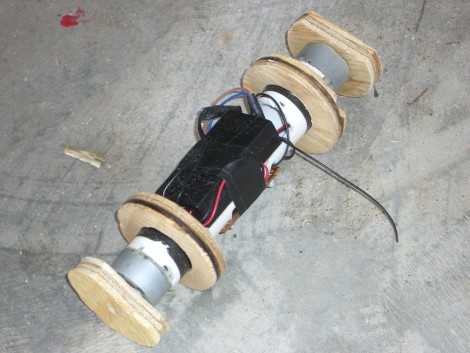
This concept robot uses angular momentum to roll around. You can see that on either end of the robot there are two discs which have been cut on one side to make them off-balance. For locomotion, two DC motors spin the outer discs which are not in contact with the floor. This spinning action exerts a force in the opposite direction on the body of the vehicle, causing it to move.
It’s not a perfect system and there is one major flaw with using this system. When the forces have equalized acceleration will stop and it will eventually come to a standstill. You can’t just stop spinning the motors because that will act as a braking mechanism. But still, it’s a concept we haven’t seen before and we love the experimentation that’s happening here. Take a look at the test footage after the break and don’t hesitate to let us know if this starts causing light bulbs to flip on above your head.
[youtube=http://www.youtube.com/watch?v=p4MFSzklKzA&w=470]
[via Comment and Hacked Gadgets]
















I can’t really see any point to it. But interesting to see/know, I guess.
They should come up with a design for the spinning parts so that you can control the rotational inertia properties of them. That might be quite cool to see.
why do they need to be off-balance? I would think this would work even if they were just circular (slightly better, since there would be a greater mass and thus inertia).
@MJD – If they were circular then wouldn’t they simply spin while the device stay sin one place? The off balance wheels is what causes the inertia, right?
@Stevie – It will actually spin whether or not it’s off-balance. In the first video segment the wheels are not off-center. It’s the conservation of momentum that propels it, especially in this case.
Thanks for the info JC. Apart from being kind of interesting, what’s the purpose or point of this? It seems like a pretty inefficient way of moving something around.
@Stevie and IJ Dee-Vo – “Just because” is a very good answer. I have an idea for how to use this with something a bit more interesting, but even that is a “just because” device.
I wonder how many of the posts are “just becauses” which is a pretty good reason for doing anything. What happened to my post?
I want to see him slow down one and not the other, hopefully allowing turning.
I remember as a kid seeing a “rolling wheel” RC toy, I didn’t get to see it up close but I was fascinated and I assumed this is how it worked: The wheel was the outer body (imagine a hollow cylinder in contact with the ground) maybe 9″ tall, and inside it had an axle to which a motor was attached. The motor was then attached to a weight that extended close to the inner surface of the wheel, so you spin it one way and it pushes the weight forward and rolls the wheel forward, spin it the other way and you get a braking/reversing effect (like a hamster running in a ball, except it transmitted force through the axle instead of the inner surface of the ball). I imagine it shifted the weight left and right to turn.
I like it.
It doesn’t have to have a point beyond the intentions of the builder, who I thank for sharing the project.
Building things to explore concepts is totally cool and fun, and hey, someone else could be inspired to take it further. Who knows?
I know I’ve built more than a few things based on ideas I’ve gleaned from good ol’ HAD.
Yea, I don’t think the wheels need to be off balance. This seems to be a more primitive version of those radio-controlled balls we’ve seen on hackaday from time to time. Except with a ball, not only can they exert force forward and backward, but they can change their center of gravity from side to side in order to turn.
Neat, but I feel compelled to mention the magnificent Frisbots at this point:
http://www.youtube.com/watch?v=rlYZt32WybQ
Same basic principle– nothing but the two wheels touch the ground.
Those background vibrations, through my subwoofer, made my stomach tickle but nothing else moved luckily :)
This isn’t particularly interesting to me. Yeah, it rolls around some. The principle of operation is pretty obvious to, I think, most/all HaD readers. It’s a physical force that we’ve all experienced at some point (and probably learned in school).
If he somehow found some way to make it _keep_ moving in a straight line instead of just wobbling to a halt, then it would be interesting. Presenting this problem to the reader is kind of ridiculous because it is impossible to solve without bending the rules in some way (i.e. using some principle other than angular momentum alone). It’s almost like saying “oh we found this free energy device that doesn’t quite work, anyone have any ideas?”.
I also doubt that using asymmetric weights did anything. IIRC, momentum depends only on angular velocity and moment of inertia (the angular equivalent of “mass” in linear motion). The poster doesn’t seem to provide any reasoning for why asymmetric weights might cause the robot to continue rolling in one direction.
I think it may be interesting for “sealed” robots, for example, one that needs to “walk” in water. That way all the electronics and motors can be kept inside the body without any external part moving (appart from the whole body).